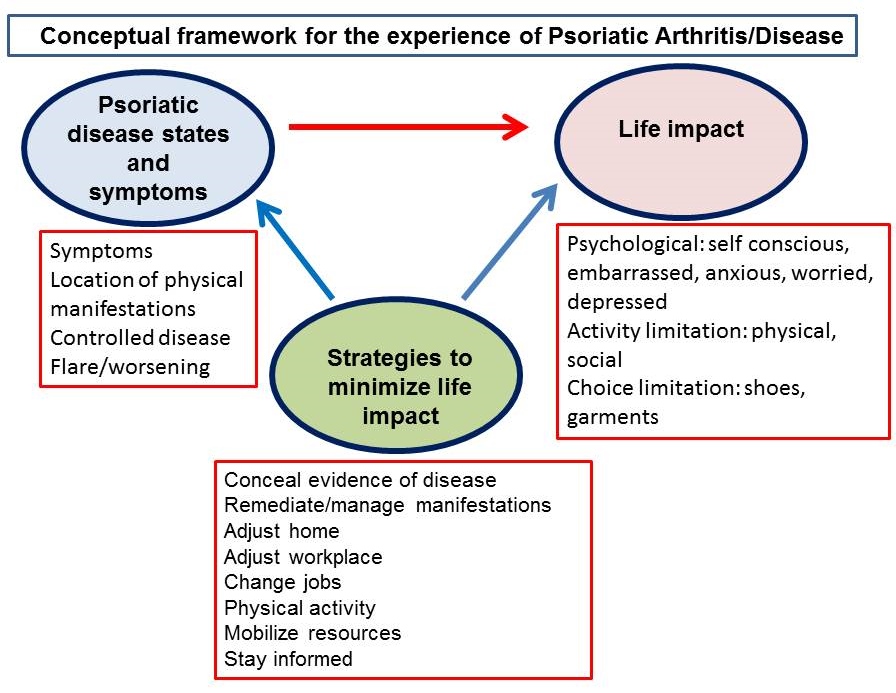Session Information
Date: Sunday, November 8, 2015
Session Type: ACR Poster Session A
Session Time: 9:00AM-11:00AM
Background/Purpose: Psoriatic arthritis (PsA) is a complex inflammatory disease with variable phenotype affecting skin, joints, ligaments/tendons, nails, and the spine. Heterogeneity of clinical manifestations complicates PsA assessment and broadens its impact (1). PsA activity is a difficult concept to measure since outcome measures in use do not systematically cover health areas prioritized by patients (2). The experience of PsA from the perspective of patients, while essential for choosing outcome measures, is not known.
Methods: Patients with PsA meeting CASPAR criteria followed longitudinally in an academic clinic were recruited after informed consent. Focus groups (FG) and individual interviews were conducted using a semi-structured guide on the following topics: 1) presence of PsA in daily life; 2) life changes since diagnosis; 3) PsA activity. Qualitative data were analyzed by 3 researchers (1 physician, 1 medical anthropologist, 1 sociologist) using inductive thematic analysis and discussions to achieve consensus.
Results: Data were analyzed from 8 participants in 2FGs and 25 participants in individual interviews. Demographics and clinical characteristics are described in Table and represent the range of PsA manifestations.
|
Table. Participant demographics and clinical characteristics |
|||
|
Participant demographics and characteristics |
FG1 (n=5) |
FG2 (n=3) |
Individual interviews (n=25) |
|
Age (years), mean(SD) |
60 (8.5) |
54.3 (4.7) |
52.9 (10.6) |
|
Sex, n(%) Female Male |
4 (80) 1 (20) |
3 0 |
16 (64) 9 (36) |
|
Race, n(%) African American Asian Caucasian Other |
0 0 5 0 |
0 0 3 0 |
0 1 (4) 23 (92) 1 (4) |
|
Ethnicity, n(%) Hispanic Non-Hispanic/Latino Not reported |
0 1 4 |
0 1 2 |
0 15(60) 10(40) |
|
Psoriatic arthritis symptom duration (yrs), mean(SD) |
15.2 (13.7) |
6.7 (6.4) |
15.8 (10.2) |
|
Psoriatic arthritis disease diagnosis duration (yrs), mean(SD) |
14.0 (13.7) |
6.7 (6.4) |
11.5 (10.8) |
|
CASPAR criteria |
|||
|
Psoriasis, n(%) Ever None |
5 0 |
3 0 |
24(96) 1 (4) |
|
Nail Psoriasis, n(%) Ever None |
2(40) 3(60) |
2(67) 1(33) |
8(32) 17(68) |
|
Dactylitis, n(%) Ever None |
2(40) 3(60) |
1(33) 2 (67) |
10(40) 15(60) |
|
Rheumatoid factor, n(%) Positive Negative Unknown |
0 3(60) 2(40) |
0 3 0 |
2 (8) 18(72) 5(20) |
|
Juxta-articular new bone formation, n(%) Yes None Unknown |
1(20) 1(20) 3(60) |
1(33) 2(67) 0 |
2 (8) 12(48) 11(44) |
|
Patient Reported Outcomes |
|||
|
mHAQ* (range 0-3), mean(SD) |
0.55 (0.69) |
0.17 (0.29) |
0.31 (0.38) |
|
Pain VAS** (0-100), mean(SD) |
41.2 (29.6) |
36.7 (53.3) |
37.8 (27.6) |
|
Patient Global Disease Activity VAS, mean(SD) |
41.8 (30.5) |
38.3 (52.0) |
34.3 (30.3) |
|
Fatigue VAS, mean(SD) |
44.2 (35.7) |
35 (52.0) |
38.0 (31.8) |
|
Stiffness VAS, mean(SD) |
53.3 (37.9) |
37.7 (50.0) |
41.4 (29.0) |
|
Patient Joints VAS, mean(SD) |
45.6 (40.7) |
29.7 (39.6) |
39.5 (29.2) |
|
Patient Skin VAS, mean(SD) |
46.3 (25.6) |
21.3 (25.2) |
30.5 (34.1) |
|
Medications |
|||
|
Biologic, n(%) Yes DMARD only |
5 0 |
3 0 |
16(64) 9(36) |
|
*mHAQ modified Health Assessment Questionnaire, score range 0-3 **VAS visual analog scale 0-100mm |
Several overarching themes and corresponding codes were identified: 1) Psoriatic disease state/symptoms; 2) Life impact; 3) Strategies to minimize life impact. A draft conceptual framework based upon the coding structure for the PsA experience is illustrated in Figure 1.
Conclusion: Participants described the PsA experience not only through symptoms but also through life impact and individual strategies to prevent/minimize impact on their life. Comprehensive PsA assessment may need to include measures for life impact and also for effectiveness of individual compensating strategies.
Figure 1. Conceptual framework for PsA experience elicited from qualitative research with participants with PsA.
- Taylor WJ, et al. Effect of psoriatic arthritis according to the affected categories of the international classification of functioning, disability and health. J Rheum. 2010;37:1885-91.
- Stamm TA, et al. Concepts important to patients with psoriatic arthritis are not adequately covered by standard measures of functioning. Arthritis Rheum. 2007;57:487-94.
To cite this abstract in AMA style:
Orbai AM, Grieb S, Bingham C, Jones M, Purwin G, Clegg-Smith K. Health Related Quality of Life in Psoriatic Arthritis from the Perspective of People Living with the Condition [abstract]. Arthritis Rheumatol. 2015; 67 (suppl 10). https://acrabstracts.org/abstract/health-related-quality-of-life-in-psoriatic-arthritis-from-the-perspective-of-people-living-with-the-condition/. Accessed .« Back to 2015 ACR/ARHP Annual Meeting
ACR Meeting Abstracts - https://acrabstracts.org/abstract/health-related-quality-of-life-in-psoriatic-arthritis-from-the-perspective-of-people-living-with-the-condition/

